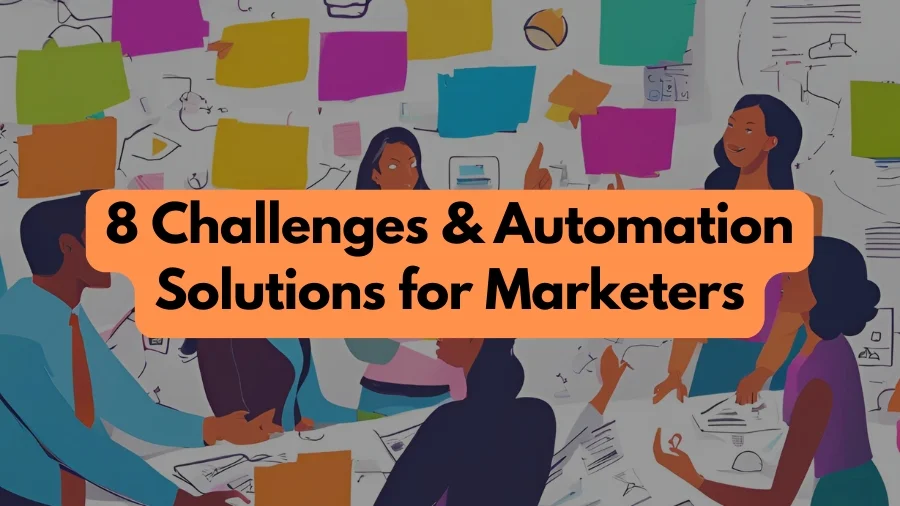Introduction
In today’s fast-paced digital world, marketers face numerous challenges in reaching and engaging their target audiences effectively. The landscape is constantly evolving, with new platforms, tools, and consumer behaviors emerging at a rapid pace. To stay competitive, marketers must overcome these challenges while optimizing their strategies for maximum impact. Marketing automation has emerged as a powerful solution, helping marketers streamline processes, personalise experiences, and measure success more accurately. In this blog post, we’ll explore the key challenges marketers face and how automation can provide effective solutions.
Key Challenges Marketers Face
1. Managing Multi channel Campaigns
The Challenge:
Today’s consumers interact with brands across multiple channels, including email, social media, websites, and mobile apps. Managing and coordinating marketing efforts across these channels can be overwhelming, especially when trying to deliver a consistent brand message and experience.
The Solution:
Marketing automation platforms allow marketers to create, manage, and track campaigns across multiple channels from a single interface. These platforms ensure consistent messaging and help marketers understand how different channels interact and contribute to overall campaign success. Automation tools can schedule posts, send emails, and even manage ad placements, ensuring that each channel is utilized effectively.
Example:
For instance, a retailer can use automation to synchronise email campaigns with social media ads and website content updates. When a new product is launched, an automated system can send a promotional email to subscribers, schedule social media posts, and update the website simultaneously. This ensures a cohesive launch campaign that reaches the audience across all touchpoints.
2. Personalizing Customer Experiences
The Challenge:
Consumers expect personalized experiences that cater to their specific needs and preferences. Delivering such personalized content manually can be time-consuming and impractical, especially for businesses with large customer bases.
The Solution:
Automation tools can collect and analyse customer data to create detailed profiles, enabling marketers to segment their audiences and deliver personalized content at scale. Features like dynamic content, behavior-based triggers, and personalized email campaigns ensure that each customer receives relevant and timely messages. This not only enhances the customer experience but also increases engagement and conversion rates.
Example:
An e-commerce company can use marketing automation to track customer browsing behavior and purchase history. If a customer frequently browses a particular category but hasn’t made a purchase, the system can automatically send personalized emails with product recommendations and exclusive offers related to that category. This targeted approach increases the likelihood of conversion by addressing the customer’s specific interests.
3. Generating and Nurturing Leads
The Challenge:
Generating high-quality leads and nurturing them through the sales funnel is a critical aspect of marketing. However, identifying potential leads and keeping them engaged until they are ready to convert can be a complex and resource-intensive process.
The Solution:
Marketing automation can streamline lead generation and nurturing through automated workflows. These workflows can include email sequences, targeted content, and follow-up actions based on user behavior. By scoring leads based on their interactions and engagement, automation tools help marketers prioritize high-quality leads and ensure timely follow-ups, increasing the chances of conversion.
Example:
A B2B software company can use automation to capture leads through web forms and automatically segment them based on their industry and company size. The system can then send a series of educational emails and case studies tailored to the specific needs of each segment, gradually moving them through the sales funnel. When a lead shows high engagement, such as attending a webinar or downloading multiple resources, they are flagged for a sales follow-up.
4. Analysing and Measuring Performance
The Challenge:
Measuring the effectiveness of marketing campaigns and understanding what works and what doesn’t is crucial for optimising strategies. However, collecting and analysing data from various sources can be daunting, and without proper insights, it’s challenging to make informed decisions.
The Solution:
Automation platforms provide robust analytics and reporting tools that consolidate data from multiple channels, offering a comprehensive view of campaign performance. Marketers can track key metrics, such as open rates, click-through rates, and conversion rates, in real-time. These insights enable marketers to make data-driven decisions, optimize campaigns on the fly, and demonstrate ROI more effectively.
Example:
A marketing team can use an automation platform to generate real-time reports on the performance of their email campaigns. By analyzing metrics such as open rates, click-through rates, and conversion rates, they can identify which subject lines, content, and CTAs are most effective. This data-driven approach allows them to continuously refine their strategies and improve future campaigns.
5. Managing Time and Resources
The Challenge:
Marketers often juggle multiple tasks, from content creation and campaign management to data analysis and reporting. Managing these tasks efficiently while meeting deadlines and staying within budget is a constant challenge.
The Solution:
Marketing automation can significantly reduce the time and effort required for repetitive and manual tasks. Automated scheduling, content distribution, and data collection free up valuable time for marketers to focus on strategy and creative aspects. This increased efficiency leads to better resource management, allowing teams to accomplish more with fewer resources.
Example:
A small business with a limited marketing team can use automation to schedule social media posts, send out email newsletters, and collect customer feedback automatically. This allows the team to focus on creating high-quality content and developing innovative marketing strategies, rather than getting bogged down by routine tasks.
6. Maintaining Customer Engagement
The Challenge:
Keeping customers engaged over time requires ongoing communication and value delivery. Without regular interaction, customers may lose interest and move to competitors, resulting in decreased retention and loyalty.
The Solution:
Automation tools can help maintain customer engagement through automated email sequences, personalized content recommendations, and timely reminders. By leveraging customer data, these tools ensure that communication is relevant and valuable, keeping customers engaged and nurturing long-term relationships. Automated surveys and feedback forms can also help marketers gather insights and continuously improve the customer experience.
Example:
A subscription service can use automation to send personalized renewal reminders and exclusive offers to existing customers. By analyzing customer usage patterns and preferences, the system can also recommend additional products or services that match their interests, keeping them engaged and encouraging upsells.
7. Aligning Marketing and Sales Efforts
The Challenge:
Misalignment between marketing and sales teams can lead to inefficiencies and missed opportunities. When these teams are not on the same page, leads may fall through the cracks, and potential sales can be lost.
The Solution:
Marketing automation platforms often include CRM integration, enabling seamless collaboration between marketing and sales teams. Automated lead scoring, segmentation, and nurturing ensure that only qualified leads are passed to sales, improving conversion rates. Shared data and insights allow both teams to align their efforts and work towards common goals, resulting in a more efficient and effective sales process.
Example:
An automation platform can synchronize marketing and sales data, providing a unified view of the customer journey. This allows both teams to track lead progress, share insights, and coordinate follow-ups effectively. For instance, when a lead reaches a certain engagement score, the system can automatically notify the sales team to initiate contact, ensuring timely and relevant communication.
8. Adapting to Market Changes
The Challenge:
The marketing landscape is constantly changing, with new trends, technologies, and consumer behaviors emerging regularly. Keeping up with these changes and adapting strategies accordingly can be challenging.
The Solution:
Marketing automation tools offer flexibility and scalability, allowing marketers to quickly adapt to market changes. Automated A/B testing and real-time analytics provide insights into what works best, enabling marketers to pivot strategies as needed. Additionally, automation platforms often offer regular updates and new features, ensuring that marketers have access to the latest tools and capabilities.
Example:
A fashion retailer can use automation to test different promotional strategies for new product launches. By running A/B tests on email subject lines, ad creatives, and landing pages, the retailer can quickly identify the most effective approach and adjust their campaigns accordingly. Real-time analytics allow them to monitor performance and make data-driven decisions, ensuring they stay ahead of market trends.
Additional Benefits of Marketing Automation
Improved Customer Insights
Marketing automation platforms collect and analyze vast amounts of customer data, providing valuable insights into customer behavior, preferences, and purchase patterns. These insights enable marketers to create more targeted and effective campaigns, improving overall marketing performance.
Enhanced Marketing ROI
By streamlining processes, reducing manual tasks, and optimizing campaigns, marketing automation helps businesses achieve better results with less effort. This leads to a higher return on investment (ROI) for marketing activities, making automation a cost-effective solution for businesses of all sizes.
Consistent Branding
Automation ensures that your brand message remains consistent across all channels and touchpoints. This consistency helps build brand recognition and trust, which are essential for long-term success.
Scalability
As your business grows, marketing automation tools can scale with you, accommodating larger audiences and more complex campaigns. This scalability ensures that your marketing efforts can keep pace with your business growth, without requiring a proportional increase in resources.
Compliance and Privacy
Automation platforms often include features to help ensure compliance with data protection regulations, such as GDPR and CCPA. Automated data management and privacy settings help protect customer information and maintain trust.
Best Practices for Implementing Marketing Automation
Start Small and Scale
Begin with a few key automation workflows and gradually expand as you become more comfortable with the platform. This approach allows you to learn and optimize your processes before scaling up.
Focus on Quality Data
Accurate and up-to-date data is essential for effective marketing automation. Invest in data management and ensure that your systems are integrated to maintain data quality.
Continuously Test and Optimize
Use A/B testing and real-time analytics to continuously monitor and improve your campaigns. Regularly review your automation workflows and make adjustments based on performance data.
Train Your Team
Ensure that your marketing team is well-trained on the automation platform and understands how to
use its features effectively. Provide ongoing training and support to keep your team up-to-date with new capabilities and best practices.
Align with Business Goals
Align your automation strategies with your overall business goals. This ensures that your marketing efforts contribute to the broader objectives of your organization and deliver measurable results.
Conclusion
Marketing automation has become an essential tool for modern marketers, addressing many of the challenges they face in an increasingly complex and competitive landscape. By automating repetitive tasks, personalizing customer experiences, and providing valuable insights, automation tools enable marketers to work more efficiently and effectively. As a result, businesses can enhance their marketing efforts, improve customer engagement, and drive better results.
Embracing marketing automation is not just about keeping up with trends; it’s about staying ahead in a rapidly evolving digital world. By leveraging the power of automation, marketers can overcome challenges, optimize their strategies, and achieve long-term success. Whether you’re a small business or a large enterprise, marketing automation offers solutions that can help you reach your goals and grow your brand in a sustainable way.



